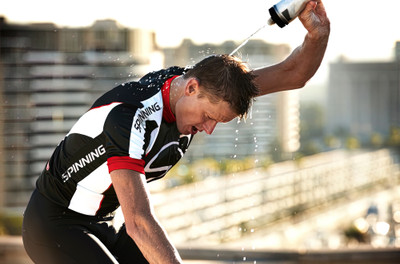
Hot Stuff: Thermoregulation
Posted by Spinning® on Jul 1st 2021
The biggest risk factor in exercise is not doing it. That said, and with summer in full swing bringing in some record-setting temps – we need to be aware of how hot conditions affect us. Being informed and on the lookout for potential problems is an important part of being a good Spinning® instructor and prudent fitness professional. It’s what keeps us healthy and safe, both on and off the bike.
How does the body work to sense and regulate temperature conditions?
The hypothalamus, located in the center of the brain, regulates body temperature and keeps it in balance (or in homeostasis). There are sensors (central thermoreceptors) located in the hypothalamus that monitor the temperature of your blood as it circulates through your brain. In your skin, you have sensors (peripheral thermoreceptors) that monitor external environmental temperatures. They work together to help the body respond to changes in body temperature to keep our internal system in balance.
There are four ways we transfer heat:
1. Conduction: Transfer of heat from one material to another (deep internal heat to the skin)
2. Convection: Transfer of heat from one place to another by the movement of gas or liquid across a heated surface (environmental air moving across skin)
3. Radiation: Transfer of heat through infrared rays (body heat transferred into clothing or sunlight transferred into the ground or a person’s body)
4. Evaporation: Heat transfer by conversion of water (sweat) to vapor
During exercise, evaporation is our body’s primary way to dissipate heat. As we exercise, we generate up to 15 times the amount of internal heat we generate at rest, which causes our body’s internal temperature to rise. The hypothalamus sends a signal to vasodilate to lose more heat through the skin by sweating. As sweat reaches the skin, evaporation of sweat becomes critical to keep cool. Sweat has to be able to evaporate into the external environment to provide cooling.
Other Environmental Conditions
Humidity is simply water vapor content in the air around us, and it’s a big factor in heat transfer and sweat evaporation. If the air around you has a high concentration of water vapor, it greatly decreases sweat evaporation. This creates additional stress on the body as the skin stays wet and heated. Sweat must evaporate to cool, and sweat that drips off the skin will not provide a cooling effect. Think of how it feels to be inside a steam room. Drip. Drip. Drip.
At this point, it is also important to note three things. First, heat dissipation is largely dependent on the gradient between the temperature outside and inside the body. Second, if it is hotter externally with a breeze blowing than internally, the breeze will “cook” you instead of cool you. (Remember the gradient between the body and the environment?) Think of how a convection oven blows heated air to cook faster. Third, the Heat Index combines the temperature of the air with the relative humidity (expressed as the Dew Point) to determine how it actually feels around you.
Paying attention to the external environmental conditions is important during the hotter months of the year, not just for good performance when we train, but also to head off any heat-related health complications that can result from exposure to excessive heat and humidity.
How does our body deal with heat and humidity during exercise?
Sweating is one of our body’s physiological responses to heat. When we sweat, our body has to increase blood flow to the skin, as sweat is a filtrate of blood plasma, which is about 99% water. The increased blood flow to the skin means that there is less blood flow to the working muscles. Increased sweat means that the plasma levels can decrease and blood becomes thicker, sticky and harder for the heart to pump. Thicker blood creates a cardiovascular response of a higher heart rate as the heart tries to compensate for the sticky, hard-to-circulate blood, resulting in decreased oxygenation of the working muscles. Hot, humid conditions can create a battle between getting the working muscles the nutrients and oxygen they need for activity, and cooling the body down through sweating. Being overheated leads to fatigue. Anything that interferes with cardiovascular response will decrease endurance performance, increase fatigue, and increase your chance of experiencing heat-related health complications.
What are health-related complications -- their signs and treatment?
Heat cramps are caused by dehydration, sweating, and losing minerals like calcium through sweating in the working muscles. They are treated by stopping activity, moving to a cooler location, and administering fluids.
Heat exhaustion is more serious, and is caused when heat cannot be dissipated quickly enough because of reduced blood volume from dehydration. Symptoms include breathlessness, fatigue, dizziness or fainting, vomiting, a weak and rapid pulse, and either hot, dry or cold and clammy skin. Treatment for heat exhaustion requires stopping activity immediately, having the person lie down with feet elevated in a cooler environment, and administering a saline drink. If the person is unconscious, they will need the administration of saline through an IV. People who are not acclimated to heat or are deconditioned are the most susceptible to heat exhaustion, and if heat exhaustion is not treated, heat stroke can result.
Heat stroke is the result of failure of the body’s cooling mechanism and needs urgent medical attention. The symptoms are an internal temperature of 104F or greater; cessation of sweating; hot, dry skin; rapid pulse and breathing; high blood pressure; confusion; and unconsciousness. If it is not treated, it results in coma and possible death. Treatment of heat stroke involves immersing a person’s body in cold water or ice and fanning the body.
| RELATED READING: Hydration 101 |
Bottom line: Exercise should improve our health, not impede it. Take all of the above knowledge and use it to educate your riders -- especially as temps soar in the coming weeks.
